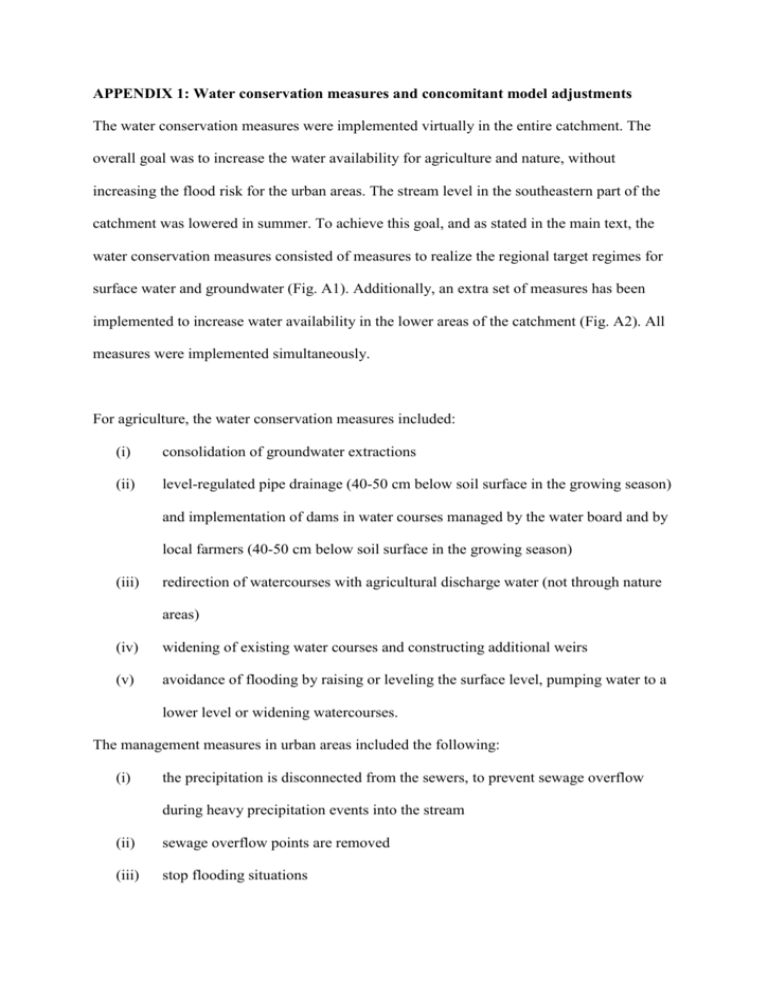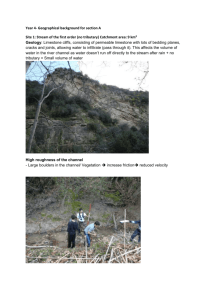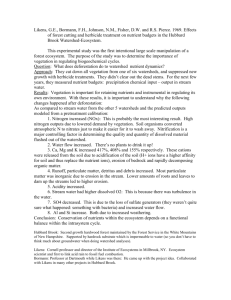APPENDIX 1: Water conservation measures and concomitant model
advertisement

APPENDIX 1: Water conservation measures and concomitant model adjustments The water conservation measures were implemented virtually in the entire catchment. The overall goal was to increase the water availability for agriculture and nature, without increasing the flood risk for the urban areas. The stream level in the southeastern part of the catchment was lowered in summer. To achieve this goal, and as stated in the main text, the water conservation measures consisted of measures to realize the regional target regimes for surface water and groundwater (Fig. A1). Additionally, an extra set of measures has been implemented to increase water availability in the lower areas of the catchment (Fig. A2). All measures were implemented simultaneously. For agriculture, the water conservation measures included: (i) consolidation of groundwater extractions (ii) level-regulated pipe drainage (40-50 cm below soil surface in the growing season) and implementation of dams in water courses managed by the water board and by local farmers (40-50 cm below soil surface in the growing season) (iii) redirection of watercourses with agricultural discharge water (not through nature areas) (iv) widening of existing water courses and constructing additional weirs (v) avoidance of flooding by raising or leveling the surface level, pumping water to a lower level or widening watercourses. The management measures in urban areas included the following: (i) the precipitation is disconnected from the sewers, to prevent sewage overflow during heavy precipitation events into the stream (ii) sewage overflow points are removed (iii) stop flooding situations For nature areas the following measures were implemented: (i) small ditches are removed or shoaled (ii) drainage is restricted (iii) impermeable layers are constructed in the underground and ploughed layers are removed (iv) streams are restored and non-local water is redirected from the nature area (v) allocated additional nature habitats And finally in natural stream valley areas we implemented these measures: (i) further stream restoration (including meandering of the stream and restoration of the natural profile, where the surface has been adjusted to 50% normative discharge) (ii) stop of groundwater extraction and level-regulated pipe drainage within the stream valley zones Figure A1. Location of the water conservation measures to comply to the regional target regimes. The stream water levels in the different areas are shown on top for the winter and summer situation. Where applicable also the level-regulated water levels are shown. Stream restoration was implemented in the entire natural stream valley zone. Figure A2. Locations of the additional water conservation measures. These measures were implemented in the lower parts of the catchment and are solely focused on increasing water availability in those areas. All above measures were implemented in the groundwater model to simulate the management effects. Possible downsides of the above-mentioned measures are the increased risk of flooding if the water table increases too much. This may be desired in the nature areas, but not in the agricultural parcels where it can lead to an increased risk of water-induced crop damage. Additionally, the following model adjustments have been implemented to simulate the establishment of the new stream valley zone. All changes apply to the stream valley zone only. There have been no adjustments to the areas around the stream valley zone. SOBEK model (surface water) The flow resistance has been adjusted to regular winter values (15 m-3 s-1) all year round, because the 50% normative discharge (ND) only occurs in winter. The surface profile of the stream has been adjusted to make it more natural; the surface profile equals the surface of the 50% ND. If the stream flows through a peat area, then 30% ND will be used. The remeandering of the stream equals a factor 1.3 its current length. Re-meandering is only done if the surrounding land area allowed it. SIMGRO model (unsaturated zone) The irrigation in the stream valley zone has been turned off (value = 0). For precipitation and evaporation values we used the climate scenarios as input. MODFLOW model (saturated zone) The level-regulated pipe drainage in the stream valley zone has been removed from the model (No data values). APPENDIX 2: Validation of PROBE model with management data The PROBE output was validated with data available on the management types of the different nature areas. Since PROBE produces vegetation types (Witte and Van der Meijden 2000), we linked the vegetation types output to management types based on Van Ek et al. (Van Ek et al. 2014). Not all vegetation types could be translated into management types since some vegetation types are related to semi-terrestrial instead of fully terrestrial nature. For this case study area, sixteen out of 25 vegetation types could be validated through a management type (Table A1). The following nine could not be linked to a management type: A11, A12, A15, A16, A18, K42, K48, K68 and H41. Table A1. Translation of vegetation types into management types. The left column is the vegetation type, the right the management types that can be linked to that vegetation type. For an explanation of the vegetation types see table 1 in the main text. Nine vegetation types could not be linked to a management type and were therefore not validated. Vegetation type Management type K27, K28 swamp K21, K41 moist heath H21,H22,H27,H47H61,H62,H67 river and stream forest K22 wet nutrient poor grassland K27, K28 moist nutrient poor grassland K62, K67 dry nutrient poor grassland K47 fauna and herb rich grassland H47 hornbeam and ash forest H61, H62 pine, oak and beech forest H61,H62,H67 dry production forest K61 dry heath K47 mesotrophic grassland H47 moist (old) coppice forest H47 moist production forest We considered the model to be successful when the management type (real data) at a certain location is represented by (one of) the right vegetation types. Approximately 64% of the modelled nature areas matched the management data and approximately 26 % did not match. Ten percent of our model area was not validated. The vegetation in the ‘no-match’ cells was often modelled too dry or occasionally too wet. The acidity and nutrient availability predictions were also sometimes incorrect, although not as often as the water availability. Occasionally, two (or three) abiotic factors were modelled incorrect at one site. There was rarely a mismatch between short (herbaceous) vs. high (forest) vegetation. Figure A3. Validation of the PROBE model. Only vegetation types in the nature areas have been tested. Green fields indicate a match between observed and modelled data, while red fields indicate that there is no match. Grey areas are the ecotypes which could not be validated. As it shows from the figure, most data could be successfully validated. References Van Ek R, Witte JPM, Mol-Dijkstra JP et al (2014) Ontwikkeling van een gemeenschappelijke effect module voor terrestrische natuur. STOWA 2014-22:ISBN 978.90.5773.658.2 Witte JPM, Van der Meijden R (2000) Mapping ecosystem types by means of ecological species groups. Ecological Engineering 16(1):143-152







